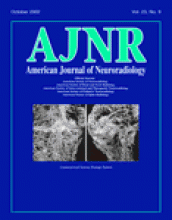Abstract
BACKGROUND AND PURPOSE: Although neuropsychological symptoms and signs are common in thyroid disease, their organic substrate is unknown. We performed brain MR imaging in patients with hyperthyroidism or hypothyroidism before and after treatment and correlated the results with hormonal markers.
METHODS. Eight patients with hyperthyroid disease and three with hypothyroid disease underwent imaging within 1–2 days of a thyroid hormone testing. Images were registered, and brain and ventricular sizes were measured by using a semiautomated contour and thresholding technique. Changes in brain and ventricular volume were correlated with serum levels of total thyroxine (T4), unbound triiodothyronine (free T3), and thyroid-stimulating hormone (TSH) before and after treatment.
RESULTS. With treatment, brain size decreased by 6,329–31,183 mm3 in the hyperthyroid group and increased by 2,599–48,825 mm3 in the hypothyroid group. Conversely, with treatment, ventricular size increased by 325–6,279 mm3 in the hyperthyroid group and decreased by 760–2,376 mm3 in the hypothyroid group. There was a highly significant correlation between reduction in brain size and reduction in T4, as well as between the increase in ventricular size and reduction in T4. There was a significant correlation between reduction in ventricular size and reduction in free T3. There were highly significant correlations between reduced levels of TSH and increase in brain size, as well as between increased levels of TSH and increase in ventricular size.
CONCLUSION. In thyroid disease, the size of the brain and ventricles significantly change after treatment, and these changes are correlated with T4, free T3, and TSH levels. The mechanism of these changes is uncertain, but it may involve osmolyte regulation, the sodium and water balance, and alterations in cerebral hemodynamics.
- Copyright © American Society of Neuroradiology











